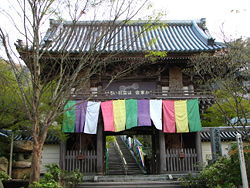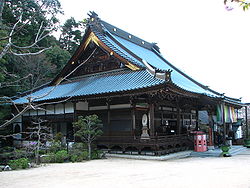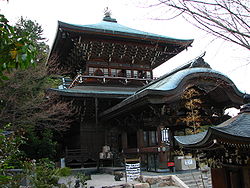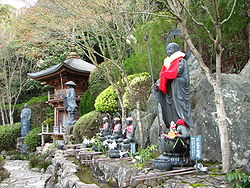
Daisho-in (Miyajima)
Encyclopedia




Mount Misen (Miyajima)
is the holy mountain on the holy island Itsukushima in Hatsukaichi, Hiroshima, Japan; it is situated within the World Heritage area of Itsukushima Shrine.The sea around the island and all of the island are within Setonaikai National Park....
, the holy mountain in the island of Itsukushima
Itsukushima
is an island in the western part of the Inland Sea of Japan, located in the northwest of Hiroshima Bay. It is popularly known as , the Shrine Island. The island is one of . Itsukushima is part of the city of Hatsukaichi in Hiroshima Prefecture...
in Miyajima-chō in the city of Hatsukaichi, Hiroshima
Hatsukaichi, Hiroshima
is a city of some 120,000 people located in Hiroshima Prefecture, Japan. The name derives from a market traditionally held on the 20th of each month with hatsuka meaning "20th day" and ichi translating to "market"...
, Japan
Japan
Japan is an island nation in East Asia. Located in the Pacific Ocean, it lies to the east of the Sea of Japan, China, North Korea, South Korea and Russia, stretching from the Sea of Okhotsk in the north to the East China Sea and Taiwan in the south...
. It is the 14th of Chūgoku 33 Kannon Pilgrimage
Chugoku 33 Kannon Pilgrimage
The is one of a number of traditional Buddhist pilgrimage routes in Japan. The route includes 33 sites sacred to the boddhisattva Kannon, across the Chūgoku region...
and famous for autumn leaves and maples. It has another temple name called . Including Mt.Misen, Daishō-in is within the World Heritage
World Heritage Site
A UNESCO World Heritage Site is a place that is listed by the UNESCO as of special cultural or physical significance...
Area of Itsukushima Shrine
Itsukushima Shrine
Itsukushima Shrine is a Shinto shrine on the island of Itsukushima in the city of Hatsukaichi in Hiroshima Prefecture in Japan...
.
In this temple there is a flame is which is said to have been burning since its foundation, for more than 1200 years.
History
- Daishō-in was founded by the monk KūkaiKukaiKūkai , also known posthumously as , 774–835, was a Japanese monk, civil servant, scholar, poet, and artist, founder of the Shingon or "True Word" school of Buddhism. Shingon followers usually refer to him by the honorific titles of and ....
, also known posthumously as , in the year 806, the 1st year of the Daidō eraDaidowas a after Enryaku and before Kōnin. This period spanned the years from May 806 through September 810. The reigning emperors were and .-Change of era:* November 16, 806 : The new era name 'was created to mark an event or series of events...
.
- Kūkai was one of the most famous monks in Japan and the founder of Shingon BuddhismShingon Buddhismis one of the mainstream major schools of Japanese Buddhism and one of the few surviving Esoteric Buddhist lineages that started in the 3rd to 4th century CE that originally spread from India to China through traveling monks such as Vajrabodhi and Amoghavajra...
. - So, it's the head temple of one of the denominations of Shingon Buddhism and the oldest temple in Itsukushima.
- An Imperial order by Emperor TobaEmperor Tobawas the 74th emperor of Japan, according to the traditional order of succession.Toba's reign spanned the years from 1107 through 1123.- Genealogy :...
, it was the place to pray for the peace and security of the nation. - Emperor MeijiEmperor MeijiThe or was the 122nd emperor of Japan according to the traditional order of succession, reigning from 3 February 1867 until his death...
was staied on July 31, 1885 for his visit to Itsukushima ShrineItsukushima ShrineItsukushima Shrine is a Shinto shrine on the island of Itsukushima in the city of Hatsukaichi in Hiroshima Prefecture in Japan...
. - Repair work for the trail to Mt.MisenMount Misen (Miyajima)is the holy mountain on the holy island Itsukushima in Hatsukaichi, Hiroshima, Japan; it is situated within the World Heritage area of Itsukushima Shrine.The sea around the island and all of the island are within Setonaikai National Park....
was finished in 1905.
- An Imperial order by Emperor Toba
- It was done by the donation of Itō HirobumiIto HirobumiPrince was a samurai of Chōshū domain, Japanese statesman, four time Prime Minister of Japan , genrō and Resident-General of Korea. Itō was assassinated by An Jung-geun, a Korean nationalist who was against the annexation of Korea by the Japanese Empire...
.- Heavy damage by 19th typhoon on September 27, 1991.
- Held a memorial service to congratulate the restoration of the damage on October 10, 1998.
- The 14th Dalai Lama visited Itsukushima to celebrate the 1200th-year of Daishō-in from the 3rd to 8th of November in 2006.
There are also many buildings, gates of the temple and many statues of Kannon
Kuan Yin
Guanyin is the bodhisattva associated with compassion as venerated by East Asian Buddhists, usually as a female. The name Guanyin is short for Guanshiyin which means "Observing the Sounds of the World". She is also sometimes referred to as Guanyin Pusa...
, Jūichimen Kannon, Acala
Acala
In Vajrayana Buddhism, Ācala is the best known of the Five Wisdom Kings of the Womb Realm. He is also known as Ācalanātha, Āryācalanātha, Ācala-vidyā-rāja and . The Sanskrit term ācala means "immovable"; Ācala is also the name of the eighth of the ten completion stages of the Bodhisattva path...
and Seven Lucky Gods
Seven Lucky Gods
The , commonly referred to in English as the Seven Lucky Gods, refer to the seven gods of good fortune in Japanese mythology and folklore. They are often the subject of netsuke carvings and other representations.Each has a traditional attribute:...
on and around Mt.Misen.
See also
- ItsukushimaItsukushimais an island in the western part of the Inland Sea of Japan, located in the northwest of Hiroshima Bay. It is popularly known as , the Shrine Island. The island is one of . Itsukushima is part of the city of Hatsukaichi in Hiroshima Prefecture...
- KūkaiKukaiKūkai , also known posthumously as , 774–835, was a Japanese monk, civil servant, scholar, poet, and artist, founder of the Shingon or "True Word" school of Buddhism. Shingon followers usually refer to him by the honorific titles of and ....
- Shingon BuddhismShingon Buddhismis one of the mainstream major schools of Japanese Buddhism and one of the few surviving Esoteric Buddhist lineages that started in the 3rd to 4th century CE that originally spread from India to China through traveling monks such as Vajrabodhi and Amoghavajra...
- KannonKuan YinGuanyin is the bodhisattva associated with compassion as venerated by East Asian Buddhists, usually as a female. The name Guanyin is short for Guanshiyin which means "Observing the Sounds of the World". She is also sometimes referred to as Guanyin Pusa...
- Chūgoku 33 Kannon PilgrimageChugoku 33 Kannon PilgrimageThe is one of a number of traditional Buddhist pilgrimage routes in Japan. The route includes 33 sites sacred to the boddhisattva Kannon, across the Chūgoku region...
- Mt.MisenMount Misen (Miyajima)is the holy mountain on the holy island Itsukushima in Hatsukaichi, Hiroshima, Japan; it is situated within the World Heritage area of Itsukushima Shrine.The sea around the island and all of the island are within Setonaikai National Park....
- AcalaAcalaIn Vajrayana Buddhism, Ācala is the best known of the Five Wisdom Kings of the Womb Realm. He is also known as Ācalanātha, Āryācalanātha, Ācala-vidyā-rāja and . The Sanskrit term ācala means "immovable"; Ācala is also the name of the eighth of the ten completion stages of the Bodhisattva path...
- Seven Lucky GodsSeven Lucky GodsThe , commonly referred to in English as the Seven Lucky Gods, refer to the seven gods of good fortune in Japanese mythology and folklore. They are often the subject of netsuke carvings and other representations.Each has a traditional attribute:...
- For an explanation of terms concerning Japanese Buddhism, Japanese Buddhist art, and Japanese Buddhist temple architecture, see the Glossary of Japanese BuddhismGlossary of Japanese BuddhismThis is the glossary of Japanese Buddhism, including major terms the casual reader might find useful in understanding articles on the subject. Words followed by an asterisk are illustrated by an image in one of the photo galleries...
.
External links
34.29195°N 132.318475°W

